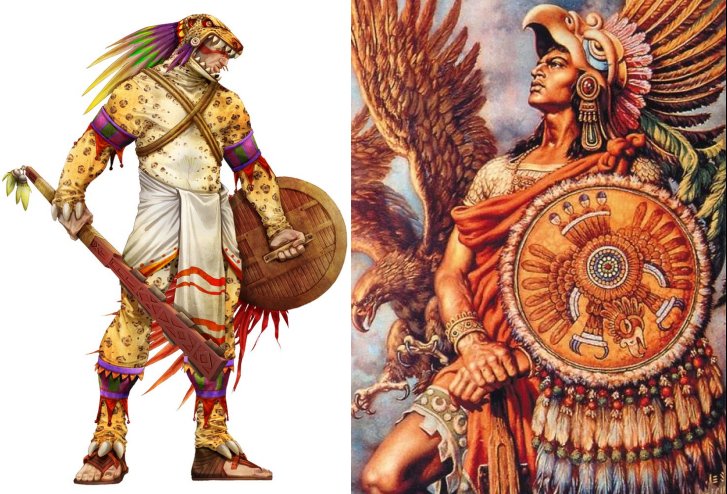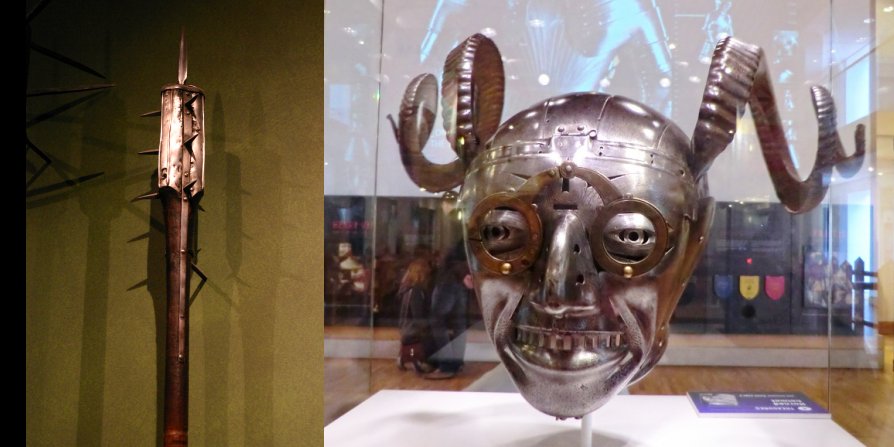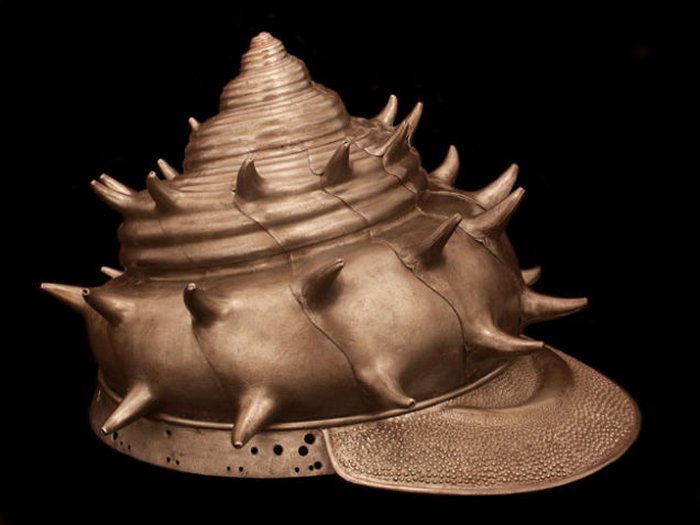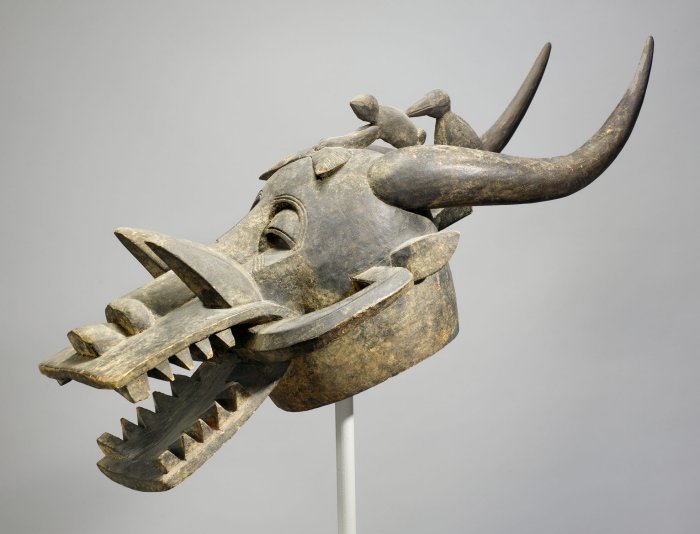Truly Bizarre And Most Fearsome Ancient Helmets Ever Seen
AncientPage.com - Going to war in ancient times involved more than just great military strategy and excellent warrior skill. To conquer your enemy, it was assumed the warriors must look as fearsome as possible.
We have previously seen that Aztec Eagle Warriors and Jaguar Warriors who were without doubt some of the most skilled and feared fighting forces of the ancient world wore special armor and headdresses. Eagle Warriors were adorned in eagle feathers and wore headgear with an eagle head on it, their faces looking out from an open beak. Jaguars wore suits made from the pelts of pumas (jaguars) and associated themselves with their god of night.
It is believe that Vikings filed their teeth to frighten opponents in battle or to show their status as a great fighter.
The Winged Hussars were one of the most effective military forces in the world. The Winged Hussars were known for the wings with long feathers worn on their backs or attached to the saddles of their horses, which during a charge uttered a sound of vibrating feathers that frightened enemy infantry.
King Henry VIII is today often remembered for his many marriages. He also played a critical role in the English Reformation, turning his country into a Protestant nation. King Henry VIII also had an unusual taste in weapons and armour.
Helmets fitted with mask-like visors were a popular German and Austrian fashion about 1510 to 1540. With their visors forged and embossed as humorous or grotesque human masks, such helmets were often worn in tournaments held during the exuberant pre-Lenten (Shrovetide) festivals, celebrations somewhat akin to the modern Mardi Gras.
Grotesque human mask-like visors were really popular in Germany and Austria in the early 16th century.
Other ancient helmets were made in the likeness of frightening animals or strange objects.
Kolman Helmschmid, Helmet (Burgonet) of Emperor Charles V, c. 1530, Patrimonio Nacional, Real Armería, Madrid
Helmet in the form of a sea conch shell, 1618, Japan
The ceremonial and parade helmets of Charles V
Desiderius Helmschmid, c. 1540
Impressive helmet masks abound in the region spanning the present-day national borders of Côte d'Ivoire, Mali, and Burkina Faso. Sculptors carve works intended to incite fear by making visual references to powerful animals, including crocodiles, warthogs, and antelopes.
See also:
Winged Hussars: Facts And History About The Polish Warriors, Their Armor And Military Tactics
Fearsome Aztec Eagle Warriors And Jaguar Warriors Of Mesoamerica
King Henry VIII’s Walking Staff And Other Unusual Weapons
The aggressive imagery artists create in helmet masks like this one contrasts with their more delicate handling of kpeliye'e face masks. Not associated with any single animal, kponyugo helmet masks foster spectators' uncertainty and apprehension.
The aggressive imagery artists create in helmet masks like this one contrasts with their more delicate handling of kpeliye'e face masks. Not associated with any single animal, kponyugo helmet masks foster spectators' uncertainty and apprehension.
Helmet Mask (Kponyugo)
The mask's open jaws and sharp teeth appear ready to devour its prey and thus visually underscore its ferocity. Members of poro and other fraternal associations in the region don composite helmet masks and full-body outfits during funerals and on other occasions to punish human lawbreakers and deter malevolent spirits.
Due to the aggressive and combative nature of the helmet masks and their performances, women and children are enjoined to avoid seeing them, a stricture honored due to the costly consequences that transgressions precipitate.
Roman Cavalry Helmet, 100-250 A.D.
The most vulnerable part of the soldier in battle was his head, so the search for protection by some form of helmet goes back to the earliest times. The technology of armor was constantly evolving and different armies during different periods favored special shapes for their helmet.
Helmets were purpose-built to protect the wearer against the specific weapons he faced, but as we have just seen, the helmets were often also especially designed and modified to frighten the enemy.
Copyright © AncientPages.com All rights reserved. This material may not be published, broadcast, rewritten or redistributed in whole or part without the express written permission of AncientPages.com
More From Ancient Pages
-
 European Medieval Burial Practices Were Different Than Previously Thought
Archaeology | Sep 13, 2021
European Medieval Burial Practices Were Different Than Previously Thought
Archaeology | Sep 13, 2021 -
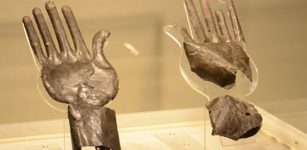 Mystery Of The Silver Hands Discovered In An Etruscan Tomb Full Of Secrets
Artifacts | Jun 12, 2015
Mystery Of The Silver Hands Discovered In An Etruscan Tomb Full Of Secrets
Artifacts | Jun 12, 2015 -
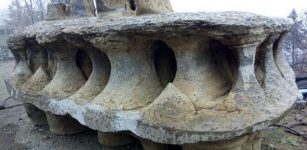 Curious Giant Shaped Rock In China – An Ancient Man-Made Construction Or Natural Formation?
Featured Stories | Jun 26, 2017
Curious Giant Shaped Rock In China – An Ancient Man-Made Construction Or Natural Formation?
Featured Stories | Jun 26, 2017 -
 Mysterious Abaj Takalik Of Guatemala And Intriguing Relationship Between Olmec and Maya
Civilizations | Mar 16, 2020
Mysterious Abaj Takalik Of Guatemala And Intriguing Relationship Between Olmec and Maya
Civilizations | Mar 16, 2020 -
 Three 1850-Year-Od Stone Ossuaries Prevented From Looting Near Kafr Kanna In Galilee
Archaeology | Jun 21, 2023
Three 1850-Year-Od Stone Ossuaries Prevented From Looting Near Kafr Kanna In Galilee
Archaeology | Jun 21, 2023 -
 Story Of Uncle Sam – Symbol Of The United States Government
Ancient Symbols | Apr 24, 2017
Story Of Uncle Sam – Symbol Of The United States Government
Ancient Symbols | Apr 24, 2017 -
 Finds At Timna Valley Date Back To King Solomon-Era And Point To Sophisticated Ancient Society
Archaeology | Mar 3, 2017
Finds At Timna Valley Date Back To King Solomon-Era And Point To Sophisticated Ancient Society
Archaeology | Mar 3, 2017 -
 Anchor Church Caves – Has The Home Of Anglo-Saxon King Eardwulf And Saint Hardulph Been Found?
Archaeology | Jul 23, 2021
Anchor Church Caves – Has The Home Of Anglo-Saxon King Eardwulf And Saint Hardulph Been Found?
Archaeology | Jul 23, 2021 -
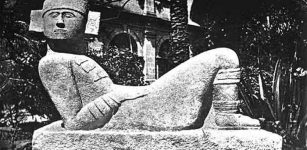 Chacmool (‘Chac-Mool’) – Intriguing Pre-Columbian Statue Found At Many Ancient Sites In Mesoamerica
Featured Stories | May 22, 2021
Chacmool (‘Chac-Mool’) – Intriguing Pre-Columbian Statue Found At Many Ancient Sites In Mesoamerica
Featured Stories | May 22, 2021 -
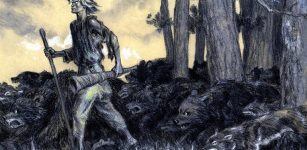 Ilmarinen – Divine Blacksmith And Trusted Friend Of Wizard Vainamoinen In Kalevala
Featured Stories | Nov 16, 2018
Ilmarinen – Divine Blacksmith And Trusted Friend Of Wizard Vainamoinen In Kalevala
Featured Stories | Nov 16, 2018 -
 Satellite Images Revealed Lost Ancient Irrigation System In Desert-Like Region Of China
Ancient Technology | Jan 6, 2018
Satellite Images Revealed Lost Ancient Irrigation System In Desert-Like Region Of China
Ancient Technology | Jan 6, 2018 -
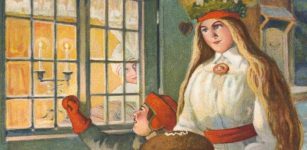 Why We Celebrate Saint Lucy’s Day – The Bringer Of Light And Patron Of The Blind
Ancient Traditions And Customs | Dec 13, 2021
Why We Celebrate Saint Lucy’s Day – The Bringer Of Light And Patron Of The Blind
Ancient Traditions And Customs | Dec 13, 2021 -
 Ancient DNA Reveals The Earliest Evidence Of The Last Massive Human Migration To Western Europe
DNA | Jul 24, 2023
Ancient DNA Reveals The Earliest Evidence Of The Last Massive Human Migration To Western Europe
DNA | Jul 24, 2023 -
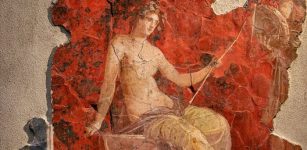 Never-Before-Seen Frescoes From Hadrian’s Time Unveiled At Ancient Roman Baths
Archaeology | Jun 27, 2022
Never-Before-Seen Frescoes From Hadrian’s Time Unveiled At Ancient Roman Baths
Archaeology | Jun 27, 2022 -
 Manasota People: Will 1,300-year-Old Village Tell Us About Their Lives?
Archaeology | Jan 11, 2016
Manasota People: Will 1,300-year-Old Village Tell Us About Their Lives?
Archaeology | Jan 11, 2016 -
 380-Million-Year-Old Heart – The Oldest Ever Found Sheds New Light On Evolution Of Human Bodies
Archaeology | Sep 16, 2022
380-Million-Year-Old Heart – The Oldest Ever Found Sheds New Light On Evolution Of Human Bodies
Archaeology | Sep 16, 2022 -
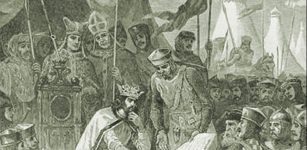 On This Day In History: Magna Carta Sealed By King John Of England – On June 15, 1215
News | Jun 15, 2016
On This Day In History: Magna Carta Sealed By King John Of England – On June 15, 1215
News | Jun 15, 2016 -
 Amazing Archaeological Discovery In A Secret Underground Structure In Transylvania Could Rewrite Ancient History
Featured Stories | Feb 13, 2024
Amazing Archaeological Discovery In A Secret Underground Structure In Transylvania Could Rewrite Ancient History
Featured Stories | Feb 13, 2024 -
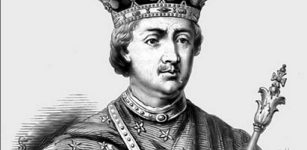 On This Day In History: Henry II Crowned King Of England – On Dec 19, 1154
News | Dec 19, 2016
On This Day In History: Henry II Crowned King Of England – On Dec 19, 1154
News | Dec 19, 2016 -
 Legacy Of The Iconic Sycamore Gap Tree – Historical Landmark At Hadrian’s Wall
Featured Stories | Mar 28, 2024
Legacy Of The Iconic Sycamore Gap Tree – Historical Landmark At Hadrian’s Wall
Featured Stories | Mar 28, 2024


